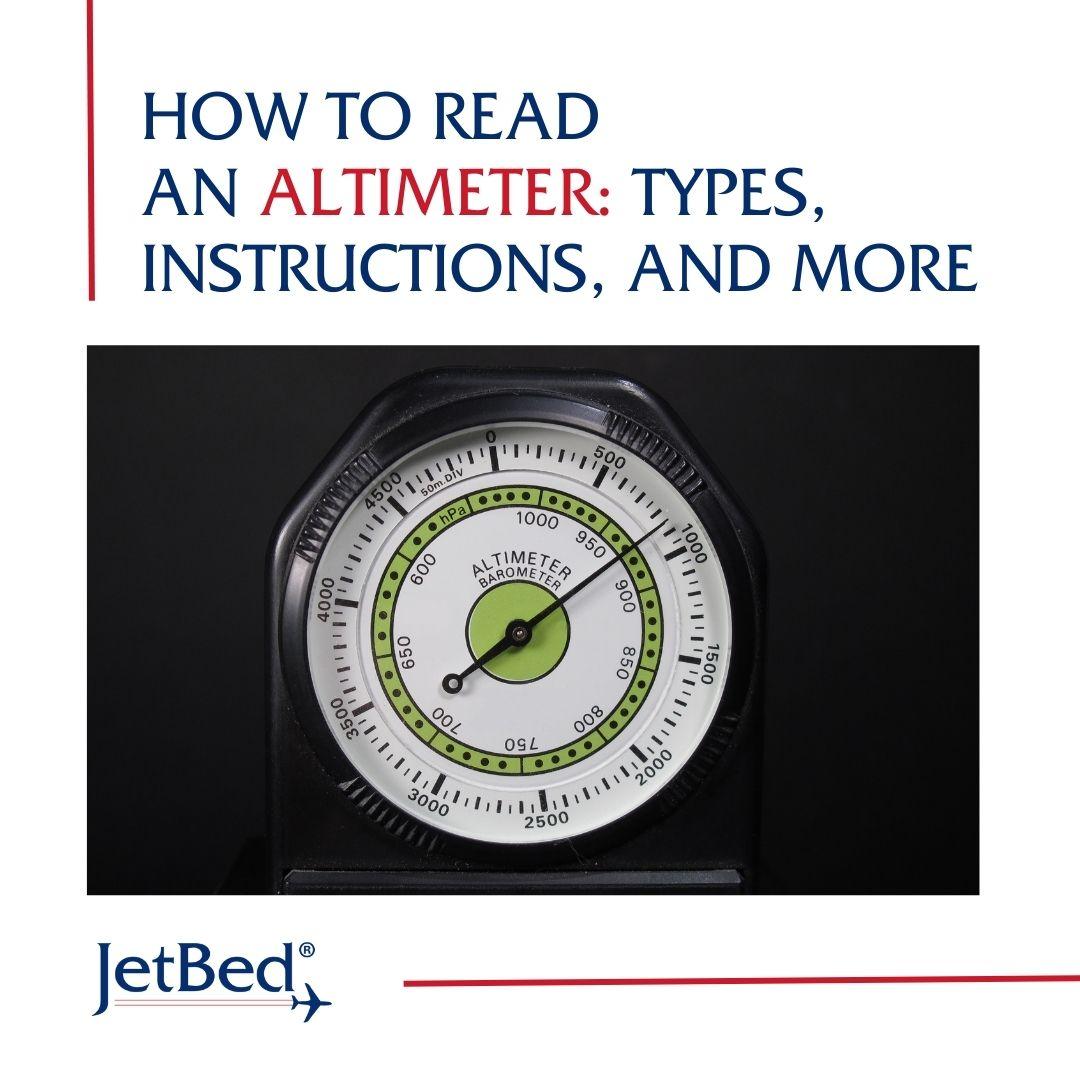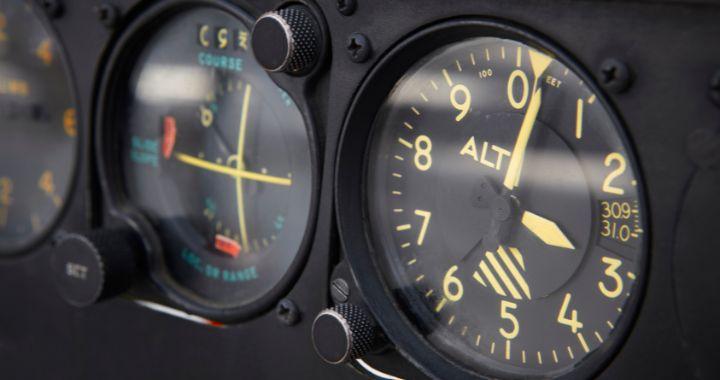Successful flying requires proficiency in operating various flight instruments. Among the most critical is the altimeter, providing crucial vertical separation awareness. As any pilot can attest, properly interpreting one’s altimeter reading takes dedicated practice!
For new pilots, mastering the altimeter proves especially important given its role in collision avoidance and regulatory compliance. Improper comprehension during critical phases like take-off and landing carries safety risks. This makes attaining altimeter reading skills a high priority from the start of flight training! Right, pilots?
With that in mind, today, we explore what an altimeter is, different types of an altimeter, and how to accurately read an altimeter! Here’s everything you need to know!
Before you dive in, be sure to check out our range of Jetbeds. Made in the USA, Jetbeds are the most comfortable way to fly!

How to Read an Altimeter: Types, Instructions, and More
While altimeters appear straightforward, proficient interpretation requires dedicated study. Subtle distinctions in instrumentation and environmental factors require deep comprehension. Why? Because learning about altimeter components, functions and styles aids in deciphering their altitude indications more precisely!
Altimeters condense complex vertical relationships into an easily referenced reading. But, relating pressure and altitude takes experience! Comprehending an altimeter as more than a single gauge illustrates why settings and presentation types impact readings. Grasping the different types of altimeters and their operations illuminates potential misreads one can make which is exactly what we will be trying to shed light on in this post!
What is an Altimeter?
The altimeter represents one of an aircraft’s most fundamental instruments. It visually conveys an aircraft’s elevation by indicating the vertical distance between that aircraft and a predefined baseline, typically mean sea level (MSL). It indicates how many feet of altitude exists between the aircraft and that level, acting as the sole instrument referencing vertical separation.
Put simply, an altimeter measures the barometric pressure of the air surrounding the aircraft. It does this using a small tube located on the exterior of the plane called a static port. This port admits external air pressure unaffected by aircraft motion or altitude.
Inside the altimeter, a sensitive aneroid barometer diaphragm measures the static port’s air pressure. As atmospheric pressure decreases with higher altitude, the diaphragm responds accordingly. The altimeter then translates this dynamic pressure reading into a quantitative altitude value on its display.
Due to air pressure variations caused by weather and temperature, the altimeter requires manual adjustment using a Kollsman window dial. This allows pilots to input the nearest reporting airport’s barometric pressure setting for localized calibration.

Different Types of Altimeters
Analog Altimeters
An analog altimeter is a style of altimeter that displays altitude using a physical rotating indicator needle rather than a digital readout. They use mechanical components like gears and springs inside with a rotating indicator on the exterior. This provides altitude information via precise needle positioning.
The faceplate is circular with two concentric scales; the outer ring denotes thousands of feet while the inner denotes hundreds of feet. A needle sweeps continuously around these scales as altitude changes, pointing to lines marking specific hundred-foot increments.
Some analogs include additional vernier lines between hundred-foot increments, increasing resolution to ~25 feet. They require no electrical power and are less complex than digital displays, making analogs more durable and common in small aircraft.
With a glance, pilots can interpret altitude to the nearest 100 feet from needle orientation relative to scale lines. Analog designs have been the standard altimeter type for decades and remain primary instruments in most general aviation planes. Their rotational visibility makes altitude assessment quick and intuitive compared to pausing on digital values.
So in summary, an analog altimeter provides a reliable mechanical reading of altitude through the physical movement of indicator needles over printed concentric feet scales. This classic design endures due to simplicity.
Digital Altimeters
A digital altimeter is an electronic type of altimeter that displays altitude using a digital readout rather than an analog needle-and-dial configuration. It uses a pressure sensor and microprocessor to determine altitude based on air pressure, then numerically displays it on an LCD or LED screen.
Digital altimeters do not have rotating pointers or physical scales like analogs. Altitude is shown simply as a crisp four to five-digit number. They require electrical power to function but have no moving parts to wear out, making digital displays highly reliable.
Precision is automatic through digital technology versus potential needle wobble on analogs. Readings are typically within 25 feet. Pilots can select various data fields such as pressure settings and trends more easily than on analogs.
Modern jet airliners primarily use digital altimeters for their precise yet simple operation in advanced flight decks. General aviation models provide the option to integrate with glass cockpit displays for modernized instrumentation. Lacking physical indicators takes slightly longer to interpret, but overall digital altimeters reduce workload with automated readouts.
All in all, a digital altimeter leverages electronics to digitally indicate altitude through an unambiguous numerical display. This provides precision pilots favor in professional aviation applications.
Pressure Altimeter
A pressure altimeter is a type of altimeter that measures altitude by using air pressure. Pressure altimeters work by measuring the atmospheric pressure of the air and translating that into a pressure altitude. As altitude increases, air pressure decreases in a predictable manner.
They have a small static port located outside the aircraft. This port allows the altimeter to measure undisturbed air pressure unaffected by aircraft speed or other factors. In the altimeter itself, a barometric sensor such as an aneroid capsule detects the air pressure from the static port. The altimeter then indicates the pressure altitude based on this reading.
Pressure altitude is the height above a standard datum pressure level, which is 29.92 inches of mercury (1013.2 mb) at sea level. This allows for standardized altitude readings regardless of actual atmospheric pressure variations on a given day.
In setting the altimeter, pilots must input the local altimeter setting, which is the current barometric pressure at an airport, to compensate for regional weather differences. This ensures the pressure altitude indication matches the true terrain altitude.
Most aircraft altimeters are pressure altimeters, as this design provides reliable and precise altitude readings essential for safe pre-flight planning and air traffic control. They remain a fundamental instrument in both visual and instrument flight rules operations.
Encoding Altimeters
An encoding altimeter is a type of altimeter that has the ability to digitally encode and transmit the aircraft’s altitude information to air traffic control. Encoding altimeters work similarly to standard pressure altimeters in how they measure air pressure and determine the aircraft’s altitude. However, they have additional encoding functionality.
The altitude readout is digitally encoded with a unique 24-bit identification code assigned specifically to that aircraft. This allows ATC to positively identify the altitude transmission source. It transmits the encoded altitude information roughly once per second to ground stations via a radio data link, typically using the Mode S transponder.
Air traffic control facilities are able to receive the encoded altitude data and monitor the identified aircraft’s vertical movements on their radar systems. Regulations require that most turbine-powered aircraft operating under IFR rules be equipped with an encoding altimeter for this surveillance function.
Encoding provides greater safety by allowing ATC to verify an aircraft is maintaining its assigned altitude clearance without having to continuously query flight crews. It also enables more automated altitude monitoring and conflict detection systems in high-traffic airspace managed by radar.
So in summary, an encoding altimeter digitally transmits an aircraft’s precise altitude transmission to ATC for surveillance and vertical separation purposes, helping maintain high standards of safety in busy airspace.
Barometric Altimeters
A barometric altimeter is a specific type of pressure altimeter that accounts for changes in barometric pressure due to weather and altitude. Like all pressure altimeters, barometric altimeters measure air pressure through a static port and indicate the corresponding pressure altitude.
However, barometric altimeters automatically adjust their output based on variations in the barometric pressure setting. This compensates for weather changes that affect air density at a given altitude. Most general aviation aircraft and airliners are equipped with barometric altimeters, as accurate altitude readout depends on the local regional pressure conditions.
Barometric altimeters have a “Kollsman window” where pilots can adjust the pressure setting to the current reported barometric pressure at their departure/destination airports. This allows the altimeter to correctly indicate true terrain elevation by referencing the modified local atmospheric pressure instead of standard pressure.
Without proper barometric adjustment, altitude indications can be incorrect by hundreds of feet depending on weather conditions. Instrument flight rules (IFR) procedures rely on corrected barometric altitude for air traffic separation, so accurate setting is critical for safety. Pilots must re-adjust barometric altimeters when flying between locations with different pressure readings to maintain precisely calibrated altitude information.
So in summary, barometric altimeters provide pressure altitude readings that self-correct based on configurable barometric pressures for each flight environment. This makes them vital for most general and commercial aviation applications.

How to Read an Aircraft Altimeter
1. Observe the Kollsman window.
The Kollsman window, found beside most altimeters, houses an adjustable ring labeled in inches of mercury (“Hg). It displays the barometric pressure currently set into the altimeter to correlate its reading with field conditions for accuracy.
2. Check the pressure setting.
Pilots verify the Kollsman window pressure corresponds to recent weather reports before takeoff. This confirms the altimeter compensation matches local atmospheric pressures to reflect true altitude rather than pressure variance.
3. Note the thousands indicator.
Analog altimeters delineate altitude in thousands and hundreds of increments. Quickly assess approximate elevation by reading the thousands of demarcation rings for immediate awareness.
4. Interpret the hundreds calibration.
A rotating needle indicates precise hundreds of feet by reference to unique markings encircling the inner hundreds scale. Take time to register the indicator’s relationship to these hash marks.
5. Cross-check a digital display.
Digital altimeters replace physical components with an electric readout. Carefully verify the reported altitude corresponds with checkpoints passed during climbs or descents.
6. Identify pressures for alternate airports.
This is especially important above 10,000 feet for precise pressure setting changes at destination fields before descending on instrument flight rules clearances.
Understanding altimeters, the different types and how it is interpreted is essential for pilots.
The importance of the altimeter to aircraft operation cannot be overstated. It is fundamental to terrain clearance, instrument flight rules, and air traffic control regulations. With vertical separation being paramount to safety, the altimeter serves as pilots’ sole altitude awareness tool. Proficiency in interpreting its readings ensures responsible decision-making at every step of each flight!
For more information on all things around aviation technology from answers to questions like What is Density Altitude? to updates on Safety Management Systems in Aviation, check out our blog!
And, if you’re looking for an easy and convenient tool that will help you and your crew avoid flight fatigue, explore our fleet of JetBeds and linens to find the one that best suits your aircraft and lifestyle!

